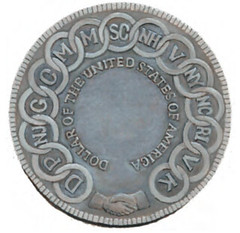
PREV ARTICLE
NEXT ARTICLE
FULL ISSUE
PREV FULL ISSUE
TWO EARLY U.S. COINAGE DESIGNS THAT NEVER WERE
Joel Orosz published a very interesting article in the December 2012 issue of The Numismatist, published by the American Numismatic Association. The title is Silver Chains & Copper Justice: Contemporary Documents Reveal Two Coinage Designs That Never Were. Here are some brief excerpts.
I had asked Joel who was responsible for the nice artist's renderings of the proposed coins, and learned they were done by Pete Smith. Nice work! -Editor
Proposed for the reverses of silver and copper coins, respectively, the Chain and Miss Justice designs were neither original, nor ultimately accepted, but certain elements of both eventually were incorporated into coins the Mint actually produced. How all this happened— and how some of it didn’t—makes for a fascinating tale from the prehistory of the U.S. Mint. The first of two proposed amendments, in its entirety, read:
On motion, to amend section 9, of the original bill, as follows: Line 9, strike out the words “and silver.” And after the word “America” in the 11th line, erase to the end of the section; and in lieu thereof insert, “And upon the reverse of each of the said silver coins, in the centre of the exergue, there shall be an engraving of two hands united, and around the margin of the piece as many circles linked together as there shall be states in the union at the time of the coinage, each circle containing the initial letters of the name of it[s] respective state; and between the representation of the united hands and the circles aforesaid, there shall be this inscription in an annular form, “Dollar of the United States of America,” where the coinage shall be of a dollar, but where the coinage shall be of parts of a dollar, expressing the same accordingly.
Since the first U.S. coin, the 1792 half disme, was not struck until July 11-13, its reverse would have had 15 links in the outer ring, one for each of the 13 original states, plus one for Vermont (admitted March 4, 1791) and one for Kentucky (admitted June 1, 1792). It would have been challenging indeed to include all this and the legend HALF DISME OF THE UNITED STATES OF AMERICA on the tiny 17.5mm coin. There can be little doubt about the Senators’ inspiration for the silver reverses: the 1776 Continental Currency “dollar” and the 1787 Fugio “cent.” The dollar depicted a ring within a ring, with the outer circle composed of 13 interlocking links, each enclosing the full name of one of the original 13 states. The inner circle featured the words AMERICAN CONGRESS. The cent was similarly designed, though the links on a variety bearing the legend UNITED STATES (instead of AMERICAN CONGRESS) are blank. Joel adds: The renderings are Pete's original oil paintings. Two of Pete's other oil paintings, one showing the Front Building, and the other the entire campus of the first Mint, are found on pages 60 and 61 of The Secret History of the First U.S. Mint.
Wayne Homren, Editor The Numismatic Bibliomania Society is a non-profit organization promoting numismatic literature. See our web site at coinbooks.org. To submit items for publication in The E-Sylum, write to the Editor at this address: whomren@gmail.com To subscribe go to: https://my.binhost.com/lists/listinfo/esylum All Rights Reserved. NBS Home Page Contact the NBS webmaster 
|


